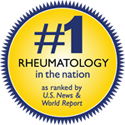The Coombs’ test is used to detect antibodies that act against the surface of your red blood cells. The presence of these antibodies indicates a condition known as hemolytic anemia, in which your blood does not contain enough red blood cells because they are destroyed prematurely. A healthy red blood cell lives for about 120 days; in people with hemolytic anemia, red blood cells are destroyed long before the 120-day marker. Sometimes, bone marrow can compensate for the early destruction of red blood cells by working overtime to make more of them. However, this extra effort may not be enough to combat hemolytic anemia.
Hemolytic anemia can either be inherited genetically or acquired. An acquired form, autoimmune hemolytic anemia (AIHA), is present in about 10% of people with lupus and results from an immune system attack on your red blood cells. People with AIHA may experience weakness, dizziness, fevers, and a yellowed complexion. Treatment calls for high doses of steroids such as prednisone, which may be supplemented with immunosuppressive medications such as azathioprine (Imuran).
There are two types of Coombs’ tests: direct and indirect. The direct Coombs’ test, also known as the direct antiglobulin test, is the test usually used to identify hemolytic anemia. [The indirect Coombs’ test is used only in prenatal testing of pregnant women and in testing blood prior to a transfusion.] For the direct Coombs’ test, blood is drawn from the vein in your arm and then “washed” to isolate your red blood cells. The red blood cells are then incubated (combined in a controlled environment) with a substance called Coombs’ reagent. If the red blood cells clump together (a process called “agglutination”), then the Coombs’ test is said to be positive.
Sources
- “Direct Antiglobulin Test.” Lab Tests Online. 8 April 2009. American Association for Clinical Chemistry. 12 July 2009 <http://labtestsonline.org/understanding/analytes/antiglobulin_direct/test.html>.
- “Coombs’ test.” Medline Plus. 8 April 2009. US National Library of Medicine and National Institutes of Health. 12 July 2009. <http://www.nlm.nih.gov/MEDLINEPLUS/ency/article/003344.htm>.


